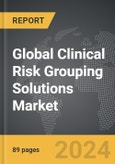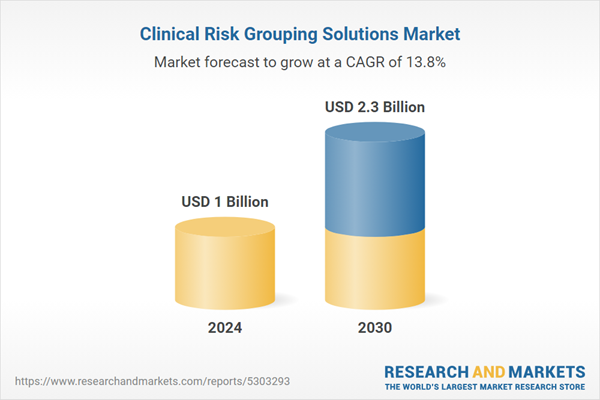The global market for Clinical Risk Grouping Solutions was valued at US$1.0 Billion in 2024 and is projected to reach US$2.3 Billion by 2030, growing at a CAGR of 13.8% from 2024 to 2030. This comprehensive report provides an in-depth analysis of market trends, drivers, and forecasts, helping you make informed business decisions. The report includes the most recent global tariff developments and how they impact the Clinical Risk Grouping Solutions market.
Segments: Product (Scorecard & Visualization Tools, Dashboard Analytics, Risk Reporting); Deployment (Private Cloud, Public Cloud, Hybrid Cloud); End-Use (Hospitals, Ambulatory Care Centers, Other End-Uses).
Geographic Regions/Countries: World; United States; Canada; Japan; China; Europe (France; Germany; Italy; United Kingdom; Spain; Russia; and Rest of Europe); Asia-Pacific (Australia; India; South Korea; and Rest of Asia-Pacific); Latin America (Argentina; Brazil; Mexico; and Rest of Latin America); Middle East (Iran; Israel; Saudi Arabia; United Arab Emirates; and Rest of Middle East); and Africa.
The analysts continuously track trade developments worldwide, drawing insights from leading global economists and over 200 industry and policy institutions, including think tanks, trade organizations, and national economic advisory bodies. This intelligence is integrated into forecasting models to provide timely, data-driven analysis of emerging risks and opportunities.
Global Clinical Risk Grouping Solutions Market - Key Trends & Drivers Summarized
Why Are Clinical Risk Grouping Solutions Essential for Healthcare Providers?
Clinical risk grouping solutions have become vital tools for healthcare providers aiming to improve patient care and optimize financial performance by identifying and managing high-risk patient populations. These solutions analyze patient data from various sources, including Electronic Health Records (EHR), claims data, and lab results, to categorize individuals based on their clinical risk profiles. By providing a comprehensive understanding of a patient's health risks, these solutions enable healthcare providers to implement proactive interventions, personalized care plans, and targeted resources for high-risk patients, which can help prevent complications, reduce hospital readmissions, and improve overall health outcomes. As the healthcare landscape shifts toward value-based care models, clinical risk grouping solutions are instrumental in helping providers achieve quality benchmarks and meet regulatory requirements. With accurate risk stratification, healthcare providers can allocate resources more effectively, ensuring that patients with complex health needs receive the appropriate level of care, ultimately leading to better health outcomes and cost containment.How Are Technological Advancements Transforming Clinical Risk Grouping Solutions?
Technological advancements are significantly enhancing the accuracy and efficiency of clinical risk grouping solutions, enabling healthcare providers to gain deeper insights into patient risk profiles and manage care more effectively. Artificial Intelligence (AI) and machine learning (ML) algorithms now play a pivotal role in analyzing large datasets, identifying patterns, and predicting potential health risks with greater accuracy. These advanced algorithms can assess variables such as past medical history, genetic factors, lifestyle habits, and social determinants of health, allowing for a more holistic view of patient risk. Predictive analytics further enable healthcare providers to anticipate health issues before they escalate, facilitating early interventions. Additionally, interoperability and integration capabilities with EHR systems and other healthcare databases have improved, allowing risk grouping solutions to access comprehensive, real-time patient information across multiple care settings. This integration not only streamlines workflow but also enhances the accuracy of risk stratification, supporting timely, evidence-based decision-making. As these technologies continue to evolve, clinical risk grouping solutions are becoming more precise, predictive, and integrated, helping healthcare providers navigate the complexities of patient risk management with greater confidence.Which Healthcare Settings Are Leveraging Clinical Risk Grouping Solutions Beyond Primary Care?
While clinical risk grouping solutions have traditionally been utilized in primary care settings to manage chronic diseases and prevent hospital readmissions, their applications are expanding into other healthcare sectors, such as specialty care, mental health, and post-acute care. In specialty care, providers use risk grouping solutions to identify patients with complex health needs, such as those undergoing cancer treatment or managing cardiovascular conditions, enabling specialists to tailor care plans to mitigate complications and enhance treatment outcomes. Mental health providers are also adopting these solutions to manage high-risk patients with conditions like severe depression or substance abuse, where proactive intervention can prevent crises and reduce the need for acute care services. In post-acute care and long-term care facilities, risk grouping solutions are invaluable for monitoring residents' health status and identifying those at risk of deterioration, helping caregivers adjust care plans accordingly. Health insurers and accountable care organizations (ACOs) are increasingly leveraging risk grouping data to design preventive programs, incentivize providers based on patient outcomes, and reduce overall healthcare costs. The adoption of clinical risk grouping solutions across these diverse settings illustrates their growing role in supporting preventive care, improving outcomes, and optimizing healthcare resources.What’s Driving Growth in the Clinical Risk Grouping Solutions Market?
The growth in the clinical risk grouping solutions market is driven by several factors, including the shift toward value-based care, advancements in data analytics, and the need to address rising healthcare costs. The transition to value-based care models, which focus on patient outcomes and cost efficiency, has made risk grouping solutions essential, as they allow providers to identify high-risk patients and proactively manage their care. Advances in data analytics, especially AI and machine learning, have enhanced the precision and predictability of these solutions, allowing for more accurate risk stratification based on a range of clinical, behavioral, and social factors. Furthermore, interoperability with EHR systems has improved, enabling seamless access to real-time patient data across care settings and making risk grouping solutions more effective and integrated into daily workflows. The ongoing pressure to contain healthcare costs has also driven the adoption of these solutions, as they help prevent expensive hospitalizations and emergency room visits by enabling early intervention for high-risk patients. Additionally, healthcare organizations are increasingly investing in clinical risk grouping solutions to meet regulatory standards, improve care quality, and enhance patient satisfaction. These factors collectively indicate a promising growth trajectory for the clinical risk grouping solutions market, driven by technological advancements and the ongoing focus on cost-effective, high-quality patient care.Report Scope
The report analyzes the Clinical Risk Grouping Solutions market, presented in terms of units. The analysis covers the key segments and geographic regions outlined below.Segments: Product (Scorecard & Visualization Tools, Dashboard Analytics, Risk Reporting); Deployment (Private Cloud, Public Cloud, Hybrid Cloud); End-Use (Hospitals, Ambulatory Care Centers, Other End-Uses).
Geographic Regions/Countries: World; United States; Canada; Japan; China; Europe (France; Germany; Italy; United Kingdom; Spain; Russia; and Rest of Europe); Asia-Pacific (Australia; India; South Korea; and Rest of Asia-Pacific); Latin America (Argentina; Brazil; Mexico; and Rest of Latin America); Middle East (Iran; Israel; Saudi Arabia; United Arab Emirates; and Rest of Middle East); and Africa.
Key Insights:
- Market Growth: Understand the significant growth trajectory of the Scorecard & Visualization Tools segment, which is expected to reach US$1.1 Billion by 2030 with a CAGR of a 15.1%. The Dashboard Analytics segment is also set to grow at 13.3% CAGR over the analysis period.
- Regional Analysis: Gain insights into the U.S. market, valued at $263.1 Million in 2024, and China, forecasted to grow at an impressive 18.2% CAGR to reach $565.8 Million by 2030. Discover growth trends in other key regions, including Japan, Canada, Germany, and the Asia-Pacific.
Why You Should Buy This Report:
- Detailed Market Analysis: Access a thorough analysis of the Global Clinical Risk Grouping Solutions Market, covering all major geographic regions and market segments.
- Competitive Insights: Get an overview of the competitive landscape, including the market presence of major players across different geographies.
- Future Trends and Drivers: Understand the key trends and drivers shaping the future of the Global Clinical Risk Grouping Solutions Market.
- Actionable Insights: Benefit from actionable insights that can help you identify new revenue opportunities and make strategic business decisions.
Key Questions Answered:
- How is the Global Clinical Risk Grouping Solutions Market expected to evolve by 2030?
- What are the main drivers and restraints affecting the market?
- Which market segments will grow the most over the forecast period?
- How will market shares for different regions and segments change by 2030?
- Who are the leading players in the market, and what are their prospects?
Report Features:
- Comprehensive Market Data: Independent analysis of annual sales and market forecasts in US$ Million from 2024 to 2030.
- In-Depth Regional Analysis: Detailed insights into key markets, including the U.S., China, Japan, Canada, Europe, Asia-Pacific, Latin America, Middle East, and Africa.
- Company Profiles: Coverage of players such as 3M Company, 4S DAWN Clinical Software, 4S Information Systems Ltd., Cerner Corporation, Change Healthcare and more.
- Complimentary Updates: Receive free report updates for one year to keep you informed of the latest market developments.
Some of the 34 companies featured in this Clinical Risk Grouping Solutions market report include:
- 3M Company
- 4S DAWN Clinical Software
- 4S Information Systems Ltd.
- Cerner Corporation
- Change Healthcare
- Conduent Incorporated
- Cotiviti, Inc.
- Dynamic Healthcare Systems, Inc.
- Episource, Med-IQ, Inc.
- Evolent Health
- HBI Solutions, Inc.
- Health Catalyst Inc.
- Indegene
- Intalere
- Johns Hopkins University
- Lightbeam Health Solutions, LLC
- Milliman, Inc.
- Nuance Communications
- Optum Inc. (A Subsidiary of Unitedhealth Group Inc.)
- Perahealth, Inc.
- The Johns Hopkins University
Tariff Impact Analysis: Key Insights for 2025
Global tariff negotiations across 180+ countries are reshaping supply chains, costs, and competitiveness. This report reflects the latest developments as of April 2025 and incorporates forward-looking insights into the market outlook.The analysts continuously track trade developments worldwide, drawing insights from leading global economists and over 200 industry and policy institutions, including think tanks, trade organizations, and national economic advisory bodies. This intelligence is integrated into forecasting models to provide timely, data-driven analysis of emerging risks and opportunities.
What’s Included in This Edition:
- Tariff-adjusted market forecasts by region and segment
- Analysis of cost and supply chain implications by sourcing and trade exposure
- Strategic insights into geographic shifts
Buyers receive a free July 2025 update with:
- Finalized tariff impacts and new trade agreement effects
- Updated projections reflecting global sourcing and cost shifts
- Expanded country-specific coverage across the industry
Table of Contents
I. METHODOLOGYII. EXECUTIVE SUMMARY2. FOCUS ON SELECT PLAYERSIII. MARKET ANALYSISCANADAITALYSPAINRUSSIAREST OF EUROPESOUTH KOREAREST OF ASIA-PACIFICARGENTINABRAZILMEXICOREST OF LATIN AMERICAIRANISRAELSAUDI ARABIAUNITED ARAB EMIRATESREST OF MIDDLE EASTIV. COMPETITION
1. MARKET OVERVIEW
3. MARKET TRENDS & DRIVERS
4. GLOBAL MARKET PERSPECTIVE
UNITED STATES
JAPAN
CHINA
EUROPE
FRANCE
GERMANY
UNITED KINGDOM
ASIA-PACIFIC
AUSTRALIA
INDIA
LATIN AMERICA
MIDDLE EAST
AFRICA
Companies Mentioned (Partial List)
A selection of companies mentioned in this report includes, but is not limited to:
- 3M Company
- 4S DAWN Clinical Software
- 4S Information Systems Ltd.
- Cerner Corporation
- Change Healthcare
- Conduent Incorporated
- Cotiviti, Inc.
- Dynamic Healthcare Systems, Inc.
- Episource, Med-IQ, Inc.
- Evolent Health
- HBI Solutions, Inc.
- Health Catalyst Inc.
- Indegene
- Intalere
- Johns Hopkins University
- Lightbeam Health Solutions, LLC
- Milliman, Inc.
- Nuance Communications
- Optum Inc. (A Subsidiary of Unitedhealth Group Inc.)
- Perahealth, Inc.
- The Johns Hopkins University
Table Information
| Report Attribute | Details |
|---|---|
| No. of Pages | 89 |
| Published | April 2025 |
| Forecast Period | 2024 - 2030 |
| Estimated Market Value ( USD | $ 1 Billion |
| Forecasted Market Value ( USD | $ 2.3 Billion |
| Compound Annual Growth Rate | 13.8% |
| Regions Covered | Global |









